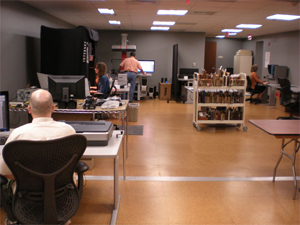 It’s a bittersweet week here in the lab. We are losing two of our family who are off to start careers and take on new adventures.
It’s a bittersweet week here in the lab. We are losing two of our family who are off to start careers and take on new adventures.
Rachel Ingold, one of our two Senior Conservation Technicians, completed library school last December and has accepted a position as the Curator of the History of Medicine Collection in the Duke University Medical Center Library and Archives. Rachel has been here for almost eight years and has proved to be a productive member of the team. More important than that is that she is a wonderful person to work with, funny, energetic and a kind soul. I will miss seeing her every day, luckily she will be just around the corner.
This is also the last week we get to see Henry Hebert in the lab. Henry was one of my SILS students and worked not only in our lab but in the lab at UNC Wilson Library. This summer he was awarded a competitive internship in the Preservation Department at Parks Library on the campus of Iowa State University. Henry is headed to the bookbinding program atNorth Bennett Street Schoolin Boston. Henry has been great to have in the lab, his energy and eagerness to learn has inspired all of us. We will miss him, but hope to see him again when he comes to visit and maybe teach us a few things.
We wish both Rachel and Henry all the best as they embark on their new lives. We will miss them both but know we will see them again. So it’s not goodbye, it’s see you later. Congratulations to you both, and good luck!
*Image: pathway from west campus to the medical center complex.






 My favorite project over the years has been building the Digital Production Center. When I started on March 14, 2005, the Digital Production Center was located on Perkins lower level behind the copy room and was often used as a shortcut from the lower level to the
My favorite project over the years has been building the Digital Production Center. When I started on March 14, 2005, the Digital Production Center was located on Perkins lower level behind the copy room and was often used as a shortcut from the lower level to the 




 Rabbi Meyer was an activist and advocate for human rights during this dark period of Argentine history, and he personally advocated for the release of political prisoners. As part of the collection that we had to digitize, there were many original hand-written letters from prisoners and other original documents filled with gut wrenching testimonies of arrests, incarcerations and torture, and the desperate plight of family members of those disappeared or incarcerated.
Rabbi Meyer was an activist and advocate for human rights during this dark period of Argentine history, and he personally advocated for the release of political prisoners. As part of the collection that we had to digitize, there were many original hand-written letters from prisoners and other original documents filled with gut wrenching testimonies of arrests, incarcerations and torture, and the desperate plight of family members of those disappeared or incarcerated.
 Alex Marsh is a Digitization Specialist in the
Alex Marsh is a Digitization Specialist in the 